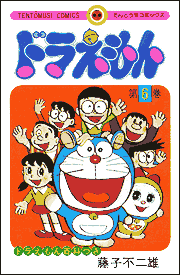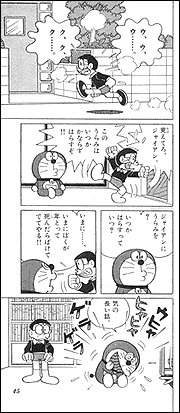Doraemon ドラえもん
Doraemon came to this world on December 1st, 1969. He was created by Fujimoto Hiroshi and Motoo Akido. Unfortunately, Fujimoto has passed away. There are hundreds of manga volumes, and a few movies. Doraemon is a story about a robotic cat sent back to the past to save a kid called Nobita Nobi from poverty in the future.
 You've seen him, even if you don't know his name. And if
you've seen him, you've been warmed—even inspired—by his energized air of
optimism. That bubble-headed creature with a broad smile, a paw raised in
greeting and a disarming blueness beams down at us not only across Japan but
on the streets of Hanoi, in courses at American colleges, in cinemas in Hong
Kong (where he chatters away in Cantonese). Yes, he sells fireworks, adorns
postage stamps, blinks as a cursor on Sony PCs and appears in movies about
the Dorabian Nights. But more than that, he transmits a message that
transcends every language: the future can be likable, the present is
redeemable, and you can be happy even if you're blue.
You've seen him, even if you don't know his name. And if
you've seen him, you've been warmed—even inspired—by his energized air of
optimism. That bubble-headed creature with a broad smile, a paw raised in
greeting and a disarming blueness beams down at us not only across Japan but
on the streets of Hanoi, in courses at American colleges, in cinemas in Hong
Kong (where he chatters away in Cantonese). Yes, he sells fireworks, adorns
postage stamps, blinks as a cursor on Sony PCs and appears in movies about
the Dorabian Nights. But more than that, he transmits a message that
transcends every language: the future can be likable, the present is
redeemable, and you can be happy even if you're blue.
For many years now the Japanese have given us all snazzy
machines and elegant styles; their animE and manga designs are so globally
compelling that the hip trans-Atlantic music group Gorillaz uses animE
figures as virtual front men, and Disney's Lion King was said to have
been inspired by the masterful cartoons of Osamu Tezuka. Athletes like
Ichiro Suzuki and Hidetoshi Nakata are increasingly electrifying
international sporting arenas with their blend of smooth craft and high
efficiency. But none of Japan's cultural exports, it could be said, has the
warmth, the companionable charm or the zany humanity of the 22nd century cat
who has a gadget, if not quite an answer, for everything.
elegant styles; their animE and manga designs are so globally
compelling that the hip trans-Atlantic music group Gorillaz uses animE
figures as virtual front men, and Disney's Lion King was said to have
been inspired by the masterful cartoons of Osamu Tezuka. Athletes like
Ichiro Suzuki and Hidetoshi Nakata are increasingly electrifying
international sporting arenas with their blend of smooth craft and high
efficiency. But none of Japan's cultural exports, it could be said, has the
warmth, the companionable charm or the zany humanity of the 22nd century cat
who has a gadget, if not quite an answer, for everything.
Doraemon lives in a world indistinguishable from our own: his weekly TV shows and annual movies have him inhabiting a typical street in a typical Japanese (and therefore quasi-Western) neighborhood. His best friend, Nobita (the name means knocked down), is a classically helpless, bespectacled fourth-grader who is always being bullied by classmates and shouted at by mother or teacher. Like any good buddy, Doraemon accompanies his pal to baseball practice, sits by his side as he wrestles with his homework and tries to protect him from evil-eyed Suneo and the lumbering Gian. Unlike most best friends however, Doraemon sleeps (as Nobita lays down his futon on the floor) in a closet. His time machine is, well, to be honest, in a desk.
Like the most immortal of such characters, in short—one thinks of Snoopy or Paddington Bear—Doraemon comes with a personality and a history. He weighs 129.3 kg, his height is 129.3 cm and his birthday is Sept. 3, 2112. He has a favorite food (dorayaki—sweet bean paste sandwiched between two small pancakes) and a little sister, Dorami, who is yellow and has ears and long eyelashes (a cousin, perhaps, of Hello Kitty). While Japan's idoru, or mass-produced pop stars, often seem as generic as machines, the country's animated characters, like Doraemon, have the bigheaded individuality of real rebels.
Part of Doraemon's particular appeal though, is that, like Hanna-Barbera's irresistible Top Cat and Yogi Bear, he is ready to take on every situation—and likely, somehow, to get it wrong. Each time Nobita is being afflicted, Doraemon will reach into the fourth-dimensional pocket in his stomach and pull out a takekoputa (flying device) or a dokodemo door, which allows them to go anywhere. But the two can only fly low over the suburban houses in the neighborhood, and the dokodemo door often takes them to the places they most wish to avoid. The reason Doraemon is blue, according to the most recent accounts, is that a robot mouse bit off his ears, and he was so rattled by his girlfriend's ensuing laughter that he turned a little turquoise. The suspicion persists, in fact, that in the realm of 22nd century cats, Doraemon is something of a Nobita.
There is a distinctly Japanese quality to all this, in the ingenuity of the Doraemonic gizmos (all portable), his determination to put a bright face on things and never to give up, and even in some of the little cat's idiosyncrasies (one of his machines allows him and Nobita to watch Shizuka-chan, the little girl who is the object of Nobita's affections, in the shower). At heart, Doraemon is profoundly human: it's the very essence of his charm that he has a girlfriend—a small cat called Mi-chan—but she always seems a little out of reach.
Indeed, Doraemon's crossover appeal may be best appreciated if you set him next to the other cartoon figure that Japan has long made ubiquitous. Hello Kitty seems to have no reason to exist other than to be cute. Utterly adorable, often clad in pink and entirely passive, she seems to represent what little Asian girls are told to be in public. Doraemon, by comparison, is as tubby and twinkling as a salaryman after one too many beers. Hello Kitty, after all, has no mouth and never moves; Doraemon seems often to be all mouth, and in every 30-minute episode of his show, is to be seen worried, chortling, goggle-eyed, at peace or pounding on the floor in frustration and then calmly dipping his paw into a bag of cookies.
 Scholars of the form may place him in the distinguished
line of Astro Boy, Osamu Tezuka's early-'60s creation, who had
100,000-horsepower hydraulics in his arms, searchlights in his wide eyes and
a nuclear fission generator in his chest. While Godzilla and Gamera, for
example, were nuclear age mutants who showed how science could turn on us,
Doraemon (like Astro Boy) offers a more hopeful and benign version of
technology. Others might liken his impact not just to that of PokEmon but to
the Totoro of Hayao Miyazaki, the visionary animator-craftsman whose
ravishing Hiroshige dusks and ecological parables are so commanding that
Disney bought the U.S. rights to all his work. But, really, Doraemon belongs
in a category of his own: not just a companion (like Winnie the Pooh) and
not just an icon (like Mickey Mouse). While Bart Simpson says and does what
all of us fear to do, Doraemon does what we dream of doing. As Donald
George, the global travel editor of Lonely Planet Publications, says,
following a video showing of Doraemon in Oakland, California: "He represents
a wonderful combination of innocence and imagination—and you come away with
that childlike feeling that anything really is possible. It's the same
feeling I get when I travel."
Scholars of the form may place him in the distinguished
line of Astro Boy, Osamu Tezuka's early-'60s creation, who had
100,000-horsepower hydraulics in his arms, searchlights in his wide eyes and
a nuclear fission generator in his chest. While Godzilla and Gamera, for
example, were nuclear age mutants who showed how science could turn on us,
Doraemon (like Astro Boy) offers a more hopeful and benign version of
technology. Others might liken his impact not just to that of PokEmon but to
the Totoro of Hayao Miyazaki, the visionary animator-craftsman whose
ravishing Hiroshige dusks and ecological parables are so commanding that
Disney bought the U.S. rights to all his work. But, really, Doraemon belongs
in a category of his own: not just a companion (like Winnie the Pooh) and
not just an icon (like Mickey Mouse). While Bart Simpson says and does what
all of us fear to do, Doraemon does what we dream of doing. As Donald
George, the global travel editor of Lonely Planet Publications, says,
following a video showing of Doraemon in Oakland, California: "He represents
a wonderful combination of innocence and imagination—and you come away with
that childlike feeling that anything really is possible. It's the same
feeling I get when I travel."
The other part of the Doraemon legend that has made him an evergreen source of nostalgia in Japan for three decades now (or, in a country of fads, 300 fashion spin cycles) is the story behind the story. Most of the country knows the heart-tugging tale of Hiroshi Fujimoto, who created Doraemon in comic-book form in 1969 and then recruited his old elementary school classmate Abiko Moto to work with him (when Fujimoto died, in 1999, it was front page news). And Nobuyo Oyama, who gives Doraemon his voice, is such an institution that she regularly appears on Japanese TV as a performer in her own right. As Japan transforms itself weekly to try to find its place in the modern world, Doraemon is one of the few constants who can bring a grandma in a kimono and a yellow-haired teenager together; so far, he's outlasted 17 Prime Ministers.
Does that make him a hero, you might ask? A hero, in Joseph Campbell's formulation, is an archetypal figure who leaves home, overcomes obstacles and in some way speaks to the universal feeling inside us that we can do more than we are doing and become better versions of ourselves. By that criterion, the sometimes blundering but always triumphant cat with the irrepressible gleam in his eye more than qualifies. He takes the very condition that we associate with melancholy—being blue—and makes it smile.
Japanese Culture and Society Links
Japanese Sports 競技 (スポーツ)
Japanese Food 食品 (しょくひん)
Japanese Pop Culture 文化(ぶんか)
- Hello Kitty Phenomena
- Japanese Anime, Japanese Manga
- Japanese Hair Straightening: All You Ever Wanted to Know
- Japanese Karaoke
Miscellaneous
- Creating a Japanese Garden Theme
- Keeping and Handling Japanese Inro
- Misconception about Ninja
- Japanese Bonsai
- Japanese Geisha
- Japanese Wedding
- Why Do Japanese Have Long Lifespan?
- Decorate with Japanese Art
Japanese Literature Links
- Haiku Poetry
- Japanese Alphabet
- Japanese Language
- Japanese Pronunciation
- Learning Japanese Kanji
- Tanka Poems
Japanese Art Links